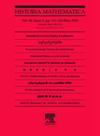14世纪自然哲学中的数学想象。无尽的螺旋线的例子
IF 0.4
3区 哲学
Q3 HISTORY & PHILOSOPHY OF SCIENCE
引用次数: 0
摘要
摘要 在本文中,我们结合有关无限性、连续性和不可分割实体存在性的辩论,列举并详细讨论了出现在 14 世纪自然哲学文献中的几何实例。在文章的第一部分,我们重点讨论了理查德-基尔文顿发明的 "比例 "螺旋线(linea girativa)的特性,他明确地将这种线描述为无限长的几何实体。尽管这一结论在数学上是一致的,但与基尔文顿同时代的许多人和后来的学者都极力反对这一结论。在文章的第二部分,我们介绍了反对 14 世纪初牛津自然哲学中出现的原子论的几何论据。作者之所以使用这些几何论证,是因为它们在驳斥原子论方面比逻辑论证或哲学论证更有效。在这些讨论的基础上,我们最后就中世纪晚期思想家在亚里士多德自然哲学背景下对数学证明的有用性所持的态度提出了一些结论。 摘要在本文中,我们结合对无限性、连续性和不可分割实体的存在的讨论,对十四世纪自然哲学文本中提出的几何例证进行了汇编和详细讨论。在文章的第一部分,我们重点讨论了对理查德-基尔文顿发明的 "成比例 "螺旋线(linea girativa)属性的争议。尽管这一结论在数学上是一致的,但他的许多同代人以及后来的学者都极力否认这一结论。在文章的第二部分,我们将介绍十四世纪初牛津自然哲学中出现的针对原子论的几何论证。这些几何论证被其作者认为比逻辑或哲学论证 "更有效 "地证明了原子论的错误。在这些讨论的基础上,我们最终就中世纪后期学者对亚里士多德自然哲学中数学证明的有用性的态度提出了一些结论。本文章由计算机程序翻译,如有差异,请以英文原文为准。
Mathematical imagination in 14th-century natural philosophy. The case of the endless, infinite helix line
Résumé
Dans cet article, nous listons et discutons en détail les exemples géométriques apparaissant dans des textes de philosophie naturelle du XIVe siècle dans le contexte des débats relatifs à l'infini, au continu et à l'existence d'entités indivisibles. Dans la première partie de l'article, nous concentrons sur les propriétés de la spirale 'proportionnelle' (linea girativa) inventée par Richard Kilvington, qui décrit clairement cette ligne comme une entité géométrique infiniment longue. Beaucoup de ses contemporains et d'auteurs scolastiques plus tardifs tentèrent ardemment de rejeter cette conclusion, en dépit de sa cohérence mathématique. Dans la seconde partie de l'article, nous présentons les arguments géométriques employés contre les théories atomistes apparues dans la philosophie naturelle oxfordienne du début du XIVe siècle. Ces arguments géométriques furent utilisés par leurs auteurs en raison de leur plus grande efficacité, comparée aux arguments logiques ou philosophiques, pour réfuter l'atomisme. Sur la base de ces discussions, nous présentons enfin quelques conclusions à propos de l'attitude des penseurs de la fin du Moyen Âge concernant l'utilité des preuves mathématiques dans le contexte de la philosophie naturelle aristotélicienne.
Summary
In the present paper we compile and discuss in detail the geometrical examples presented in fourteenth-century natural philosophical texts in the context of discussions on infinity, continuity, and the existence of indivisible entities. In the first part of this article we focus on the controversies over the properties of the “proportional” helix line (linea girativa), invented by Richard Kilvington, who unambiguously described this line as an actually infinitely long geometrical entity. Many of his contemporary as well as later scholastic authors tried fervently to deny that conclusion, in spite of its mathematical consistency. In the second part of the article we present the geometrical arguments used against the atomistic theories appearing in Oxford natural philosophy at the beginning of the fourteenth century. These geometrical arguments were recognized by their authors as “more efficacious” in proving atomism false than logical or philosophical ones. On the basis of these discussions we finally present a few conclusions concerning the attitude of later medieval scholars about the usefulness of mathematical proofs in the context of Aristotelian natural philosophy.
求助全文
通过发布文献求助,成功后即可免费获取论文全文。
去求助
来源期刊

Historia Mathematica
数学-科学史与科学哲学
CiteScore
1.10
自引率
0.00%
发文量
29
审稿时长
72 days
期刊介绍:
Historia Mathematica publishes historical scholarship on mathematics and its development in all cultures and time periods. In particular, the journal encourages informed studies on mathematicians and their work in historical context, on the histories of institutions and organizations supportive of the mathematical endeavor, on historiographical topics in the history of mathematics, and on the interrelations between mathematical ideas, science, and the broader culture.
 求助内容:
求助内容: 应助结果提醒方式:
应助结果提醒方式:


